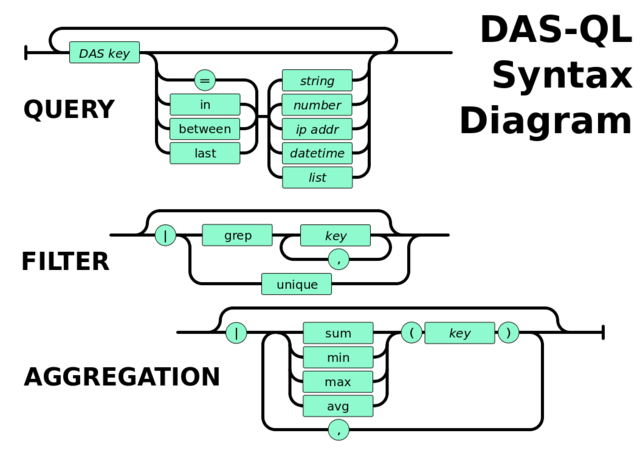DAS Query Language¶
DAS Query Language (DAS-QL) provides intuitive, easy to use text based queries to underlying data-services. Its syntax is represneted in the following diagram

We can represent it via set of pipes, similar to UNIX pipes, the key look-up fields followed by filter and/or aggregator:
<key> <key> = <value> ... | <filter> <key.att> <op> <value>, ... | <aggregator>, ...
<key> date last <value h|m>
<key> date between [YYYYMMDD, YYYYMMDD]
Here the <key> is a valid DAS key, e.g. dataset, run and <op> is a valid DAS operator, e.g. <, >, <=, >=. The <key.att> represents a key attribute. They are deduced form the DAS records. For instance, if file record contain size, id, md5 fields, all of them can be used as attributed of the file key, e.g. file.md5. But the attributes cannot appear in look-up part of the query.
The DAS query can be supplemented either by filters or aggregator functions. The filter consists of filter name and key/key.attributes value pair or key/key.attributes fields. The support filters are: grep, unique, sort. To unique filter does not require a key.
The supported aggregator functions are: sum, count, min, max, avg, median. A wild-card patterns are supported via asterisk character.
Here is just a few valid examples how to construct DAS query using file and dataset keys and file.size, dataset.name key attributes:
file dataset=/a/b/c | unique
file dataset=/a/b/c | grep file.name, file.size
file dataset=/a/b/c | sort file.name
file dataset=/a/b/c | grep file.name, file.size, | sort file.size
file dataset=/a/b/c | sum(file.size)
file dataset=/a/b/c | grep file.size>1 | sum(file.size)
file dataset=/a/b*
Special keywords¶
DAS has a several special keywords: system, date, instance, records.
- The system keyword is used to retrieve a records only from specified system (data-service), e.g. DBS.
- The date can be used in different queries and accepts values in YYYYMMDD format as well as can be specified as last value, e.g. date last 24h, date last 60m, where h, m are hours, minutes, respectively.
- The records keyword can be used to retrieve DAS records regardless from their content. For instance, if one user place a query site=T1_CH_CERN*, the DAS requests data from several data-services (Phedex, SiteDB), while the output results will only show site related records. If user wants to see which other records exists in DAS cache for given parameter, he/she can use records site=T1_CH_CERN* to do that. In that case user will get back all records (site, block records) associated with given condition.